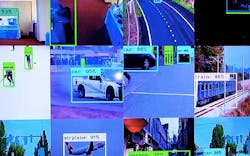The Smart Cities exhibit area at CES grew by nearly 25% over 2019, with exhibitors including the Department of Transportation, Hitachi Vantara and Siemens – all offering ways of unifying existing silos to make citizens safer and operational systems more efficient.
When there is cross-fertilization of city data, unpredictable innovations and data patterns are inevitably born. If the 2010s were the decade of sensors, the 2020s will add intelligence; in fact, the security industry might just have to consider retiring platform names like “video management” and “physical security information management” in favor of not just managing data, but creating useful operations from business intelligence.
“The more disruptive way is to tear down silos – of energy, traffic, buildings – to make them talk to each other [via an] IoT platform to come,” Siemens CTO Roland Busch told me on the show floor.
At the Hitachi Vantara exhibit, visitors were greeted by a wall of graphic use cases – from smart spaces to cities, from data warehouses to object-oriented storage – where the platform accesses data stored across many locations. The user interfaces I visited illustrated how diverse applications, old and new, could be unified.
“The real goal here is to give (customers) additional years of life from their existing investment and overlay it with new technology to really extend their capabilities and bring them additional functionality,” Hitachi Vantara Southwest Sales Director Chuck Reeves said.
Additionally in the smart city environment, both legacy video surveillance and cameras with Time of Flight (ToF) 3D sensors have created a large influence. Attendees got a 3D “selfie” emailed to them as they tried out ToF cameras used for facial recognition, access control, robotics and vehicle entries. Hitachi Vantara also provides the longer-range LiDAR devices for public safety and retail intelligence.
“In a 3D environment, the activity we are collecting data on and provide the customer with insight as to what’s happening, how it is happening, wait times, dwell times, and even retail product movement within the LiDAR field of view,” Reeves explained.
5G and AI Innovation
At CES 2020, AI seemed to be the key “ingredient technology” that seeped into most exhibits. While AI adoption is increasing, we will also find LTE and 5G technology working together for the foreseeable future. Carriers and mobile operators such as Verizon, Sprint, AT&T, Nokia and Ericsson, all demonstrated the latest advancements in 5G’s speed, reliability and efficiency.
Low-power “edge” AI processing devices exhibited at CES 2020 reduced the need and cost to transmit or process video using 5G networks. “Another class of sensors supporting AI processing at the edge are machine vision ‘smart cameras’ – using scalable hardware with dual multi-core CPUs that provide high-speed image processing and onboard analysis right in the camera,” explained Irv Rosenblum of Tattile North America, which makes software and cameras for license plate recognition.
Smart machine vision cameras are paving the way for AI chip makers like Hailo, whose chips can be used when quick processing at the edge is needed. Hailo’s deep learning chip improves the performance of sensors in advanced driver-assistance systems, engine control units and side-view mirror warnings. Autonomous vehicles harness the power of a full “data center on wheels,” with near latency-free computing. In smart cities, these fast AI chips enable cameras to detect threats to public safety and assist with critical tasks such as locating missing persons, finding stolen vehicles, or more effectively enforcing traffic violations. Multiple, full HD video streams for traffic, airports, transportation and city centers can be processed locally and quickly with high privacy.
Steve Surfaro is Chairman of the Public Safety Working Group for the Security Industry Association (SIA). Follow him on Twitter, @stevesurf.
About the Author

Steve Surfaro
Steve Surfaro
Steve Surfaro is Chairman of the Public Safety Working Group for the Security Industry Association (SIA) and has more than 30 years of security industry experience. He is a subject matter expert in smart cities and buildings, cybersecurity, forensic video, data science, command center design and first responder technologies. Follow him on Twitter, @stevesurf.
